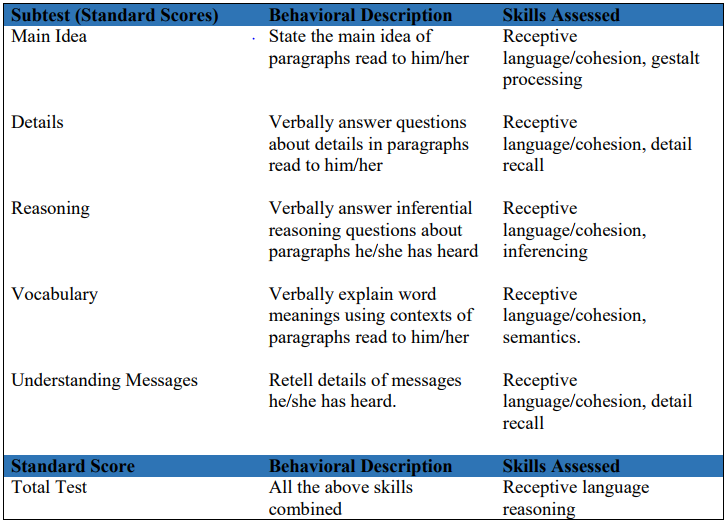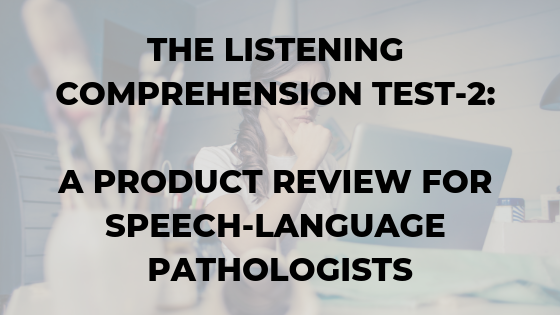What follows is an in-depth review of The Listening Comprehension Test-2 (Bowers, Huisingh, & LoGuidice, 2006); a staple evaluation tool if you’re an SLP treating school age language disorders.
There have been many cases when this assessment has saved some of my students from falling through the cracks; and the case I’m about to describe is no different.
Case Study: Meet “John”
It was getting to the point when there was not enough coffee to get me through the days. I’d reached the point in the year that my schedule was dragging and I was sick of it already.
The optimism about “changing the world” and “this year’s gonna be different” had faded with my challenging cases, and the one sitting in front of me was no different.
I’ll call him “John”. John was in third grade, and he’d been getting some type of speech or language services since he was three. Every year I’d cross my fingers and hope he’d be ready to dismiss, but things just weren’t clicking.
The last time he’d been re-evaluated, he’d just barely qualified. I thought that surely he’d be ready to cut lose when he was due for re-evaluation at the end of third grade; which was why I chose the Listening Comprehension Test-2 for my assessment of choice.
When I was honest with myself, I couldn’t say that the year had gone well. It wasn’t one of those times when you dismiss a student because they’ve made great strides.
Rather, it was a time when he was likely to be dismissed because I didn’t know what else to do with him and he hadn’t made much progress.
John was a frequent flyer in the principal’s office for discipline concerns. The general consensus from the staff working with him was that his problems were 100% effort.
He could do the work, but he was just lazy.
He knew the answers to all of the reading comprehension questions, but he was choosing to be defiant and give incomplete answers.
He knew what to write, but he wasn’t answering in complete sentences because he “didn’t feel like it.”
He just needed a behavior system to help “motivate” him.
Or so we thought.
At this point in the year, I was thinking he wouldn’t continue to qualify for speech and language services. We were sure that he understood the material, but just to be sure, I used what I like to refer as a “weeder” test.
So…what is a “weeder” test?
The Listening Comprehension Test-2 is probably one of my favorite “weeders” for kids in late elementary school with processing difficulties
“Weeder test” is no technical term (I literally just made it up). But I started to use this to describe tests like the Listening Comprehension Test-2, because I’ve come to notice over the years that certain language evaluation tools are more sensitive than others.
Some measure vocabulary on a basic level, while others are significantly more challenging and truly tax higher level cohesion skills.
A “weeder” test is one of those tests that you give those students when you want to be sure, with little doubt, that there aren’t underlying language issues that could be impacting them in school. Some tests, while they give valuable information, don’t dig deep enough.
For students who have been on your caseload forever, who may be ready to be dismissed, you want to pick a test that is sensitive enough to “weed” out these lingering language processing issues.
For John, my “weeder” of choice was the Listening Comprehension Test-2 because I wanted to get to the bottom of the, “Is he just lazy or is he really struggling?” debate.
The Listening Comprehension Test-2 was ideal for the task because it taps both measures of expressive and receptive vocabulary. I have a free summary of the test (pictured below) you can get here.
I’ve outlined what’s entailed in the test in detail in my Testing Time-Saver for Language Evaluations; which is a tool for SLPs that provides narrative descriptions that can be copied for report-writing.
It can also be used to give a quick-reference to help SLPs figure out what tests to pick based on where their students are struggling, and it includes descriptions of 12 different language tests.
Here’s a quick screenshot of the description of the LIstenting Comprehension Test-2:

There’s a couple key reasons I liked the Listening Comprehension Test-2 for John based on the particular difficulties he was having.
Reason 1: It’s one of the best tools out there for measuring receptive language
The Listening Comprehension Test-2, obviously, is a test that measures a students’ ability to listen. No surprise there. The examiner reads paragraphs that get longer and more difficult over the course of the test; and the student has to listen and comprehend what’s being said so they can answer the follow-up questions.
The student also has to listen to basic messages that sound like things you’d have to process during functional day-to-day situations (for example, there’s one that sounds like something a teacher may say at the beginning of class; and there’s also one that sounds like a teacher giving homework instructions).
Because the majority of the information that the student will be hearing on this test closely mimics what a typical school-age child would either be hearing in their day-to-day lives AND academic discussions, the test is pretty realistic.
It’s as realistic as you can possibly get for a standardized test format; and the fact that you give it in a separate setting helps to somewhat weed out distractions that may otherwise impact a student in a “real-life” situation.
The separate setting also helps to distinguish whether the student’s ability to follow directions or answer questions is truly related to a language processing issues; or if it’s something else (like attention or motivation).
And, because the Listening Comprehension Test-2 integrates some difficult vocabulary and sentence structures in to the paragraph probes, we get a sense of our students’ ability to process multiple pieces of linguistic information at once.
Essentially, the Listening Comprehension Test-2 is structured enough that we can tease out the necessary pieces of information, but not so structured that it fails to identify a processing issue.
Reason 2: It may be a “listening” test, but it also clues you in to expressive language
The second reason the Language Comprehension Test-2 is a “weeder” is because it’s not just a “listening” test; despite the implications in the name.
A student not only needs to listen and understand multiple pieces of auditory information at once; they must also process a question, sift through the information they’ve heard, and then formulate a response that coherently answers that question.
That’s a lot at once…and John seemed to be having some breakdown in situations that required similar steps. Hence the reason this evaluation tool made sense for him.
Notice that we don’t actually get to the “expressive” portion of the process until the last step; which means that this is more complex that we think AND that an incorrect response could mean the problem happened at any point in this process (we’re not always sure where).
In other words, if the student is not completely solid at any part of this process, there will be a breakdown (whether it be understanding the vocabulary, the syntax, the grammar; or knowing how to put it all together to answer the question).
The thing is, we want to push our students to the point of breakdown so we know if a problem still exists.
In closing, I’m a big fan of the Listening Comprehension Test-2 for the depth of information it provides. It’s probably one of my top choices for assessments when I’m re-evaluating students with language impairments that are struggling with complex academic language.
I’m sure you probably want to know how John did, you can check out this post here (the results surprised me).
In the meantime, you can get the Listening Comprehension Test-2 description here.
References:


